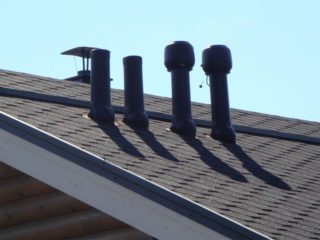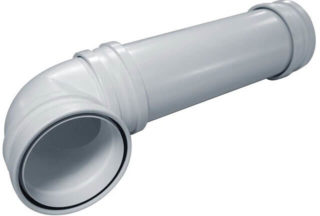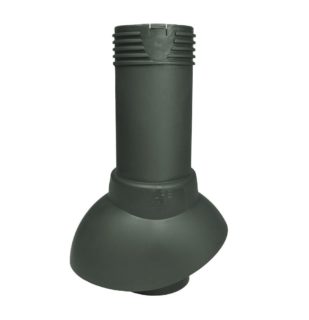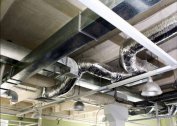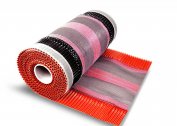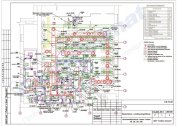When constructing a country house, all engineering communications are carefully calculated, including elements of the ventilation system of the selected type. Without a well-equipped canal designed to organize the natural or forced removal of polluted air, no commission will accept a built-up housing. Therefore, it is so important to understand the features of the output of ventilation on the roof of the building and get acquainted with the procedure for its installation within the roofing space.
What to consider
In one-or two-story buildings of a suburban type, ventilation pipes to the roof, coming from residential premises, kitchens and bathrooms, must be removed in a specially prepared place for this. With their arrangement, the vertical structure rises directly above the roof and allows you to get maximum traction. According to SNiP, when designing such a conclusion, it will be necessary to take into account the following points:
- All vertical sections of the future engineering structure are made even (without bends), which guarantees free air exit to the outside.
- It is not allowed to combine several air flows together; channels from living rooms, kitchens, attics and sewers are made separate.
- Ventilation outlets are installed as close as possible to the ridge or directly on it.
- If it is impossible to mount a direct span over the shaft, a corrugated pipe is used, which allows connecting adjacent nodes laid at different angles.
- Be sure to equip the fan section - the channel connects the sewer riser with ventilation and allows you to remove unpleasant odors.
- Air exchange is required, organized in the attic or in the attic of the building.
In fact, owners of private houses have to equip ventilation in an already finished building. In this case, you need to take into account the features of the layout of all the premises available in the house.
Pipe Type Selection
According to standard projects, for the design of ventilation ducts on the roof, the following types of pipe blanks are used:
- asbestos-cement;
- based on PVC;
- typical sewer products, the diameter of which varies between 110-200 mm.
Ventilation in a private house with access to the roof is sometimes made out in the form of a superstructure made of brick or concrete. In any case, the head of the ventilation duct is equipped with a special device that protects it from rain and snow - the deflector. By means of such an umbrella, it is possible to increase traction in strong winds.
Benefits of Ventilation with Roof Access
The advantages of arranging air ducts on the roof of the house include:
- providing good traction obtained due to the large difference in heights (pressures);
- simplicity of arrangement of vertical structures having a minimum of turns and bends;
- the ability to monitor the state of the pipe head and its maintenance.
In addition, this approach to the organization of ventilation output allows combining in one channel outlets from several types of utilities.
Specifications
Ventilation pipes presented on the domestic market have technical characteristics that depend on their type. Asbestos and ordinary sewer products are described by the following parameters:
- Basic size (working diameter).
- The degree of resistance to mechanical stress and the effects of chemically active environments.
- The temperature range in which they remain operational.
- Resistance to UV radiation.
Plastic pipes are characterized by approximately the same indicators, tied to the characteristics of a particular material. For example, polyvinyl chloride (or PVC) is resistant to UV rays, is not very expensive, the range of working temperature of pipes based on it is from -10 to + 70 degrees. Most of all it is suitable for arranging ventilation systems in bathrooms and in kitchen rooms.
Polypropylene is slightly superior to PVC in its technical indicators, as it can withstand temperatures up to + 85 degrees. In addition, it is resistant to chemically aggressive environments and is available in refractory design. Ftoroplast differs in the increased indicator of heat resistance (to + 200 degrees), and also is steady against UV and easily transfers contacts with active chemicals (alkalis and acids).
Polyethylene is characterized by a wide range of operating temperatures - from -50 to +80 degrees. It is UV resistant.
Features of installation of ventilation with access to the roof
Features of the arrangement of ventilation are considered on the example of a typical duct, laid between the roofing and the ceiling of a residential building. It is very important to choose the right place for its withdrawal to the attic, in which important building elements should not be located. In addition, increased attention is paid to the layout of the ventilation layout under the roof, since the strength of the ceiling structures in which the hole for the duct is made depends on this.
The height and diameter of the pipe depends on the conditions in which it will be operated, as well as on the type of ventilation and the volume of the room. Particular attention is also paid to the following points:
- On pitched roofs, the head of the ventilation structure is made next to the ridge, which makes it possible to do without its additional fixation.
- With this approach, most of the pipe is located in the attic or attic, where it is reliably protected from sudden changes in temperature and strong gusts of wind.
- The exit to the roof is designed in such a way that rain and snow do not fall under the roofing.
- To connect the individual elements of the duct, special flanges are required, which can be purchased at any hardware store.
Particular attention should be paid to the tightness of the pipes at the points of their exit through the roof. For this purpose, special shaped products have been developed, which are a pipe with a flexible metal base, outwardly it resembles a typical flange. During installation, it is tightly pressed to the roofing, taking the relief of the roof material from metal, for example. During installation of the duct outlet, they try to place this assembly in such a way as to achieve perfect sealing of the joints.
The pipe itself with a deflector mounted on the head, if necessary, is fixed by means of special wire extensions.
Ways to protect the ventilation pipe
Regardless of the material chosen, the roof ventilation pipe must be reliably protected from the following factors:
- mechanical (deformation) loads;
- climatic events (snow and rain);
- accumulations of condensate in the ventilation ducts;
- strong gusts of wind.
Unlike the option of extracting in a private house without access to the roof, in this case, additional protective measures have to be taken. In this case, the type of roofing material (corrugated board or similar coating) is very important, depending on which one or another decision is made. When the pipe is brought to the surface, special design pipes are used that exclude the possibility of rainfall falling under it.On a soft roof, you will need to use several rubber gaskets to protect the surface from damage.
It is possible to eliminate the formation of condensate inside the ducts and their pipe extension in the following ways:
- ventilation duct insulation;
- moisture removal;
- replacement of the existing system with forced (forced) ventilation.
In the first case, it is recommended to use standard insulation materials (mineral wool, polystyrene foam or foamed polyethylene) to warm the air ducts. Moisture accumulated in the cavity of the ventilation duct can be removed by arranging an additional pipe mounted on top of the main one. The latter option is used in cases where it is not possible to get rid of the condensate in other ways. Wire extensions help protect the pipe from strong gusts of wind.
